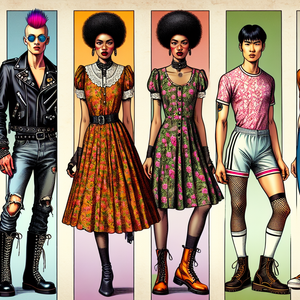The Evolution of Video Content in Advertising

Video advertising has roots that stretch back to the early days of television. The first TV commercial aired in 1941, promoting a Bulova watch, and since then, brands have utilized this medium to capture attention and drive sales. The traditional TV commercial, often characterized by high production values and star-studded casts, became the gold standard for advertisers throughout the latter half of the 20th century. However, as consumer behavior shifted with the advent of cable television and the internet, brands needed to adapt their strategies to remain relevant. The introduction of cable television in the 1980s allowed for targeted advertising, as viewers could select channels based on their interests. This change marked the beginning of a more segmented approach to advertising, prompting brands to think beyond mass-market appeal. As the internet gained traction in the 1990s, the landscape of video advertising began to shift dramatically.
The Rise of Digital Platforms
The explosion of the internet in the late 1990s and early 2000s marked a pivotal point in the evolution of video content. With platforms like YouTube launching in 2005, video became more accessible to consumers and advertisers alike. Brands began to experiment with online video, creating content that was shorter, more engaging, and tailored to specific demographics. The rise of social media platforms further accelerated this trend, as videos became a primary means of communication and brand storytelling. In the current landscape, video content is not just a supplementary advertising tool; it is a cornerstone of digital marketing strategies. In 2023, it is estimated that video will account for over 82% of all consumer internet traffic, underscoring its dominance in the advertising world. Advertisers are now able to leverage analytics to understand viewer behavior, allowing for more targeted and effective campaigns.
Creative Strategies and Storytelling Techniques
As video content has evolved, so too have the strategies brands use to engage their audiences. The shift from traditional advertising to digital has spawned a new emphasis on storytelling and emotional connections. Brands are increasingly using narrative techniques to create compelling videos that resonate with viewers on a personal level. For instance, brands like Nike and Dove have successfully leveraged storytelling to engage their audiences. Nike’s "Dream Crazy" campaign, featuring Colin Kaepernick, showcased powerful narratives of perseverance and social justice, while Dove’s "Real Beauty" campaign challenged beauty stereotypes through authentic storytelling. These examples illustrate how brands can create a profound impact by aligning their messaging with the values and aspirations of their audience. Moreover, the emphasis on authenticity has prompted brands to adopt a more relatable approach. User-generated content and behind-the-scenes videos have become popular strategies, allowing consumers to see the human side of brands. This trend toward authenticity fosters trust and loyalty, which are essential in today’s crowded marketplace.
The Impact of Technology on Video Content
Technological advancements continue to shape the video advertising landscape. High-definition video, drone footage, and 360-degree cameras have transformed the quality and scope of visual storytelling. Moreover, the rise of artificial intelligence and machine learning is enabling brands to personalize video content based on user behaviors and preferences, creating hyper-targeted advertising experiences. Furthermore, platforms like TikTok and Instagram Reels have popularized short-form video content, prompting advertisers to create quick, engaging snippets that capture attention in mere seconds. This trend reflects a broader shift toward authenticity and relatability, as brands aim to create content that feels organic and genuine rather than overly polished. Advertisers are now challenged to deliver impactful messages in a shorter timeframe, leading to innovative storytelling techniques.
The evolution of video content in advertising is a testament to the adaptability of brands in response to changing consumer preferences and technological advancements. As we look to the future, it is clear that video will continue to play a central role in brand storytelling. With the rise of immersive technologies like virtual reality and augmented reality, the potential for even more engaging and interactive video experiences is limitless. For brands willing to embrace creativity and innovation, the opportunities to connect with audiences through video content are boundless, paving the way for a new era of advertising that prioritizes emotional resonance and authentic storytelling. As the advertising landscape continues to evolve, so too will the skill sets required for professionals in the industry. The demand for visual storytelling, multimedia production skills, and a bold, imaginative spirit will become increasingly essential for those looking to thrive in this dynamic field. The future of video content in advertising will undoubtedly be shaped by those who dare to push the boundaries of creativity and technology.
Digital Video Content Producer
BuzzFeed, Red Bull
Core Responsibilities
Develop and produce engaging video content for various digital platforms, ensuring alignment with brand messaging.
Collaborate with marketing teams to conceptualize and script video projects that resonate with target audiences.
Oversee all aspects of production, including filming, editing, and post-production, maintaining high quality standards.
Required Skills
Proficiency in video editing software (e.g., Adobe Premiere Pro, Final Cut Pro).
Strong storytelling skills, with an ability to create compelling narratives that drive viewer engagement.
Familiarity with social media platforms and trends in video content consumption.
Social Media Video Strategist
Hootsuite, Shopify
Core Responsibilities
Design and implement video strategies tailored to various social media platforms, maximizing reach and engagement.
Analyze performance metrics to inform future video content decisions and optimize strategies accordingly.
Collaborate with influencers and content creators to produce authentic, user-generated video content.
Required Skills
Strong understanding of social media algorithms and video best practices.
Experience in data analysis and the ability to translate insights into actionable strategies.
Excellent communication skills for cross-functional collaboration.
Creative Director for Video Advertising
Wieden+Kennedy, Ogilvy
Core Responsibilities
Lead the creative vision for video advertising campaigns, ensuring alignment with brand identity and objectives.
Direct and inspire creative teams, from concept development through post-production, to deliver impactful video content.
Stay ahead of industry trends, integrating innovative storytelling techniques into advertising strategies.
Required Skills
Extensive experience in video production and a strong portfolio showcasing successful campaigns.
Leadership and team management abilities, with a knack for fostering creativity in team members.
Knowledge of emerging technologies in video production, such as VR and AR.
Video Marketing Analyst
Nielsen, Adobe
Core Responsibilities
Conduct in-depth analysis of video marketing campaigns, assessing performance metrics and viewer engagement.
Provide actionable insights and recommendations for optimizing future video content strategies.
Collaborate with creative teams to ensure data-driven decisions enhance campaign effectiveness.
Required Skills
Proficiency in analytics tools (e.g., Google Analytics, YouTube Analytics).
Strong analytical and critical thinking skills, with the ability to interpret complex data sets.
Familiarity with digital marketing concepts and video production processes.
Video SEO Specialist
Moz, SEMrush
Core Responsibilities
Optimize video content for search engines to improve visibility and drive organic traffic to video assets.
Conduct keyword research and implement SEO best practices specific to video content, including metadata and captions.
Monitor and analyze video performance metrics to refine strategies and enhance search rankings.
Required Skills
In-depth knowledge of SEO principles, particularly as they pertain to video content.
Experience with video platforms and tools (e.g., YouTube, Vimeo) and understanding of their ranking algorithms.
Strong written communication skills for creating optimized video descriptions and titles.


